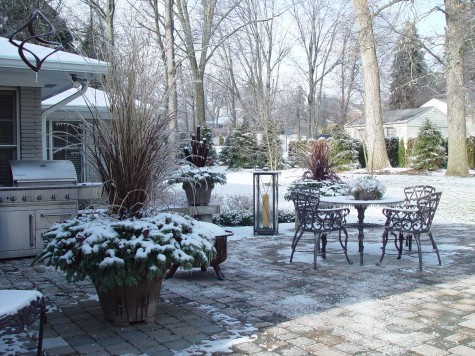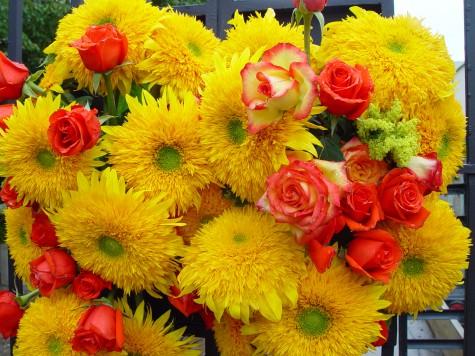 As my clients were bound and determined that Allie, Snoopy and Vladdy would be members of their wedding party, their choices for a wedding venue were slim to none. I was happy for them to get married at the shop, and equally happy to welcome the canine members of their family. Since the decision was made some six months prior to the ceremony, I had the chance to plan a garden that would look great on their late, late summer date.
As my clients were bound and determined that Allie, Snoopy and Vladdy would be members of their wedding party, their choices for a wedding venue were slim to none. I was happy for them to get married at the shop, and equally happy to welcome the canine members of their family. Since the decision was made some six months prior to the ceremony, I had the chance to plan a garden that would look great on their late, late summer date.
 A copper pergola would provide the chuppah necessary for the ceremony. We infilled the poles at each corner with birch bark tubes. This blue and white scheme dictated the selection of plants as much as the season would. A collection of Italian cypress, giant rosemary topiaries, kales and cabbages would look swell come wedding time. Luckily a local grower has a very late batch of sunflowers, including the ultra double “teddy bear”. That intense yellow would warm up the arbor in a happy and sunny way. A goldenrod garland casually draped over the chuppah provided the roof necessary for the ceremony.
A copper pergola would provide the chuppah necessary for the ceremony. We infilled the poles at each corner with birch bark tubes. This blue and white scheme dictated the selection of plants as much as the season would. A collection of Italian cypress, giant rosemary topiaries, kales and cabbages would look swell come wedding time. Luckily a local grower has a very late batch of sunflowers, including the ultra double “teddy bear”. That intense yellow would warm up the arbor in a happy and sunny way. A goldenrod garland casually draped over the chuppah provided the roof necessary for the ceremony.
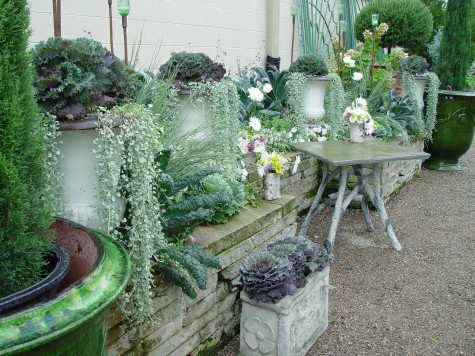 Silver dichondra has a distinctly blue cast; its diminuitive felted leaves were a great contrast to the giant blistered kale, “Nero di Toscano”. Short blue foliaged fescues, white million bells and showy oregano made good companions for the massive cabbages. White iron urns showed off the long tails of dichondra to good advantage.
Silver dichondra has a distinctly blue cast; its diminuitive felted leaves were a great contrast to the giant blistered kale, “Nero di Toscano”. Short blue foliaged fescues, white million bells and showy oregano made good companions for the massive cabbages. White iron urns showed off the long tails of dichondra to good advantage.
 As the ceremony required a table be available for the Rabbi, my clients chose a carved concrete faux bois piece whose legs were carved and acid stained to look like birch. The wedding party flowers in lime green, white, and lavender repeated the color scheme of the garden. Is that old rosemary topiary not a dream come true?
As the ceremony required a table be available for the Rabbi, my clients chose a carved concrete faux bois piece whose legs were carved and acid stained to look like birch. The wedding party flowers in lime green, white, and lavender repeated the color scheme of the garden. Is that old rosemary topiary not a dream come true?
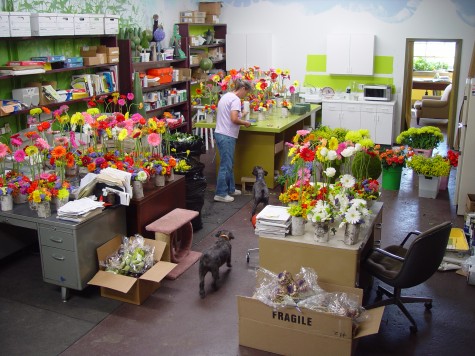 The plan for the reception involved nine 8′ long tables set end to end in the drive. Small glass vases covered in short birch bark tubes held late summer garden flowers available from the growers at my local farmer’s market. These 45 small arrangements centered on the tables would run for the entire 72 foot long reception dinner table.
The plan for the reception involved nine 8′ long tables set end to end in the drive. Small glass vases covered in short birch bark tubes held late summer garden flowers available from the growers at my local farmer’s market. These 45 small arrangements centered on the tables would run for the entire 72 foot long reception dinner table.
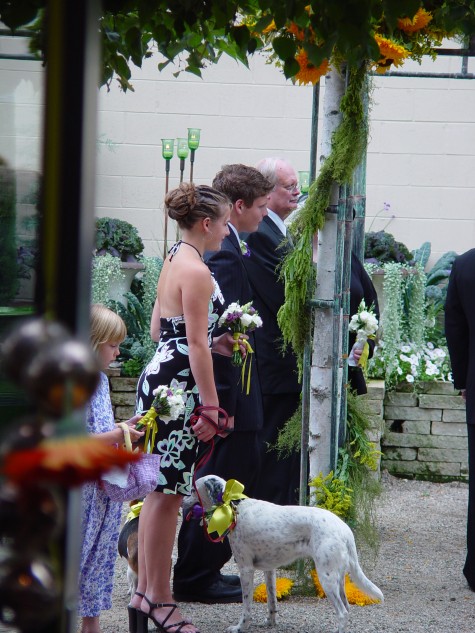 Allie and Snoopy were nervous, but they did take their big lime green satin bow and flower collars in stride. They did mill around-but just a little bit. All in all they were very well behaved.
Allie and Snoopy were nervous, but they did take their big lime green satin bow and flower collars in stride. They did mill around-but just a little bit. All in all they were very well behaved.
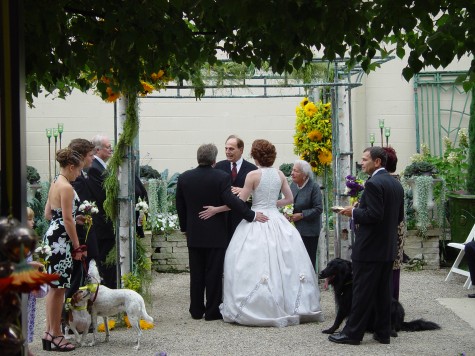 Vladdy was ordinarily fairly dignified and unflappable; he sat calmly through the entire ceremony.
Vladdy was ordinarily fairly dignified and unflappable; he sat calmly through the entire ceremony.
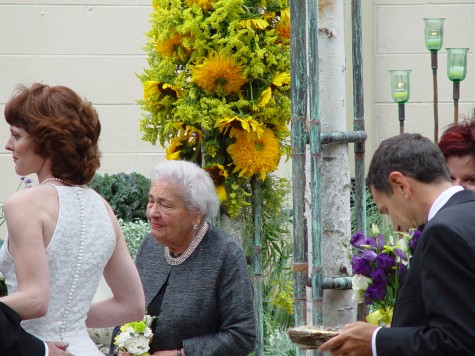 It was a beautiful wedding, and I was happy to have a part in it. There is something so satisfying about a small ceremony for everyone involved. When there are but a few details, every detail can be very personal and thoughtful. I think they were so pleased to be able to have their dog family there that day.
It was a beautiful wedding, and I was happy to have a part in it. There is something so satisfying about a small ceremony for everyone involved. When there are but a few details, every detail can be very personal and thoughtful. I think they were so pleased to be able to have their dog family there that day.
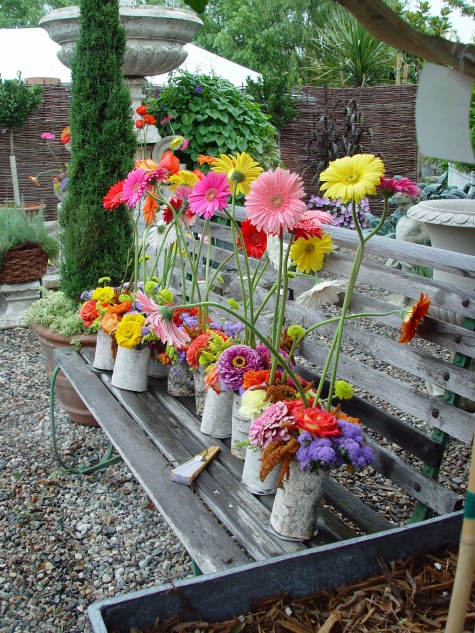
I have no pictures of the reception. I was a guest, and I participated rather than recorded. But the next day the flowers from the evening before were everywhere-a reminder of what a happy place the garden here had been everyone in attendance.
 Given that I took this picture September 24, why wouldn’t I be unprepared for the weather here this past week? Just three weeks ago, I still had my summer. Though describing any Michigan weather as “ordinary” is glossing over the truth, our weather ordinarily cools off at a slow enough pace to make keeping up with the job of putting the garden to sleep relatively easy. My fall cleanup and shovelling out is based on the distinction I draw between gardening, and housekeeping.
Given that I took this picture September 24, why wouldn’t I be unprepared for the weather here this past week? Just three weeks ago, I still had my summer. Though describing any Michigan weather as “ordinary” is glossing over the truth, our weather ordinarily cools off at a slow enough pace to make keeping up with the job of putting the garden to sleep relatively easy. My fall cleanup and shovelling out is based on the distinction I draw between gardening, and housekeeping.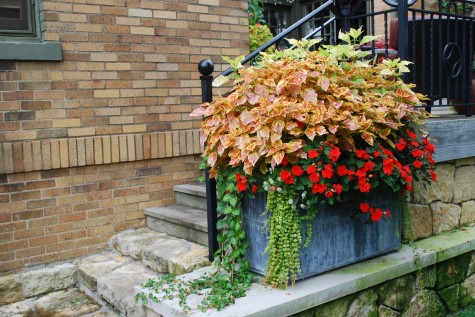 I have seen those properties that look as though every shred of organic debris has been blown, vacuumed up and disposed of weekly; anyone who has inadvertently turned a blower on themselves realize what an invasion they are. Every green leaf looks dusted; every surface has been swept, every shred or organic debris is bagged and removed. The stone is scrubbed clean, and the cushions are only on the furniture when company is in attendance. I like the look of cultivated soil as well as the next person, but all of the above is housekeeping, not gardening. Years ago a gardener whom I greatly respect, Marge Alpern, told me she disturbed her plants as little as possible. She maintained that plants can be worried such that they refuse to prosper. I think this is a point well taken. I will not take on the perennial gardens until much later in the fall.
I have seen those properties that look as though every shred of organic debris has been blown, vacuumed up and disposed of weekly; anyone who has inadvertently turned a blower on themselves realize what an invasion they are. Every green leaf looks dusted; every surface has been swept, every shred or organic debris is bagged and removed. The stone is scrubbed clean, and the cushions are only on the furniture when company is in attendance. I like the look of cultivated soil as well as the next person, but all of the above is housekeeping, not gardening. Years ago a gardener whom I greatly respect, Marge Alpern, told me she disturbed her plants as little as possible. She maintained that plants can be worried such that they refuse to prosper. I think this is a point well taken. I will not take on the perennial gardens until much later in the fall. A series of nights with temperatures hovering in the mid thirties left my pots looking like this-devastated. It does not matter one bit that I know this day is coming, I am never ready for it, nor do I like it. I do not like to let go. On a much more dramatic scale than the time changing to daylight savings, I adjust slowly, and poorly.
A series of nights with temperatures hovering in the mid thirties left my pots looking like this-devastated. It does not matter one bit that I know this day is coming, I am never ready for it, nor do I like it. I do not like to let go. On a much more dramatic scale than the time changing to daylight savings, I adjust slowly, and poorly.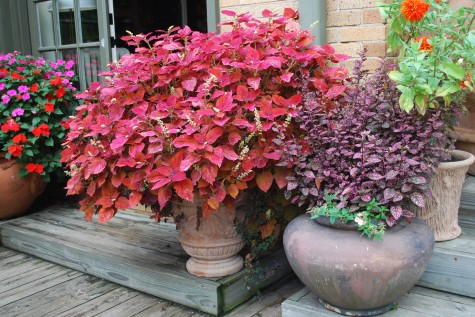 Coleus are astonishingly intolerant of cold weather. Anyone who does poorly with them is probably planting them out too early; every plant thrives in some conditions, and sulks in all else. This five foot diameter fiery orange ball was glorious all season; in late August the corgis were breaking off the branches encroaching on the doorway. They keep the extreme understory clear of any obstructions.
Coleus are astonishingly intolerant of cold weather. Anyone who does poorly with them is probably planting them out too early; every plant thrives in some conditions, and sulks in all else. This five foot diameter fiery orange ball was glorious all season; in late August the corgis were breaking off the branches encroaching on the doorway. They keep the extreme understory clear of any obstructions.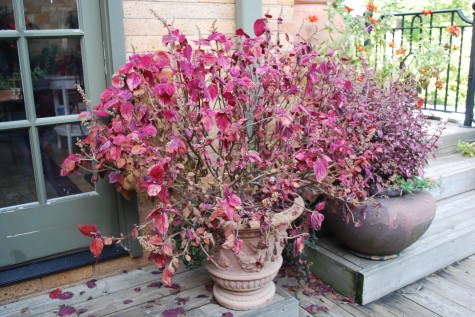 In what seemed like the blink of an eye my fireball shed almost every leaf. Unlike the gingko tree which sheds every leaf on that certain perfect fall day, leaving a beautiful pool of yellow on the ground, the coleus leaves dessicate, drop, and disappear before you can even mourn properly.
In what seemed like the blink of an eye my fireball shed almost every leaf. Unlike the gingko tree which sheds every leaf on that certain perfect fall day, leaving a beautiful pool of yellow on the ground, the coleus leaves dessicate, drop, and disappear before you can even mourn properly. 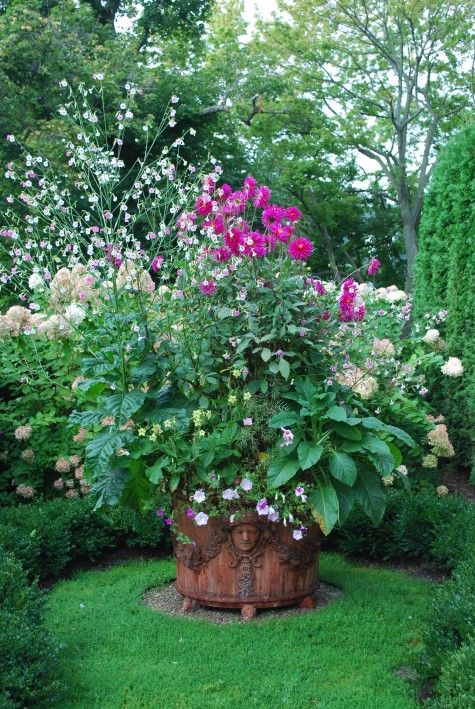 My English-made Italian style pots were home to the biggest bouquet I have ever grown. The nicotiana mutabilis got busy throwing spikes in September, and the dahlias were blooming profusely. I like that extravagant and exuberant look. No matter how the day had gone, I could go home and congratulate myself on having grown one of the annual wonders of the western world. You may be laughing, but how the look of it pleased and cheered me.
My English-made Italian style pots were home to the biggest bouquet I have ever grown. The nicotiana mutabilis got busy throwing spikes in September, and the dahlias were blooming profusely. I like that extravagant and exuberant look. No matter how the day had gone, I could go home and congratulate myself on having grown one of the annual wonders of the western world. You may be laughing, but how the look of it pleased and cheered me. 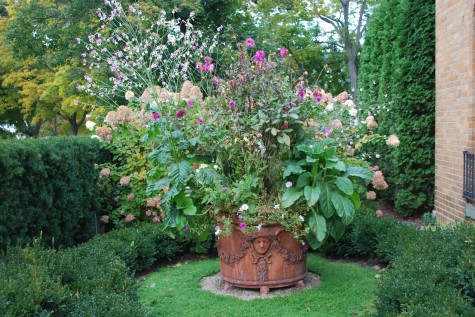 Though the nicotiana mutabilis is yet bravely defending its home, the cold pierced the heart of the whole. Buck is always amazed and amused and the depth and breadth of the despair which attends the beginning of the end of my gardening year. I alternately rage and whine-he murmurs, and pours the wine.
Though the nicotiana mutabilis is yet bravely defending its home, the cold pierced the heart of the whole. Buck is always amazed and amused and the depth and breadth of the despair which attends the beginning of the end of my gardening year. I alternately rage and whine-he murmurs, and pours the wine.  This sister to my pots, adapted for use as a fountain, bears all the signs of a season’s worth of mineral laden water, weather,heat and growth. Does that gorgeous Italianate face not seem completely grief stricken?
This sister to my pots, adapted for use as a fountain, bears all the signs of a season’s worth of mineral laden water, weather,heat and growth. Does that gorgeous Italianate face not seem completely grief stricken? 

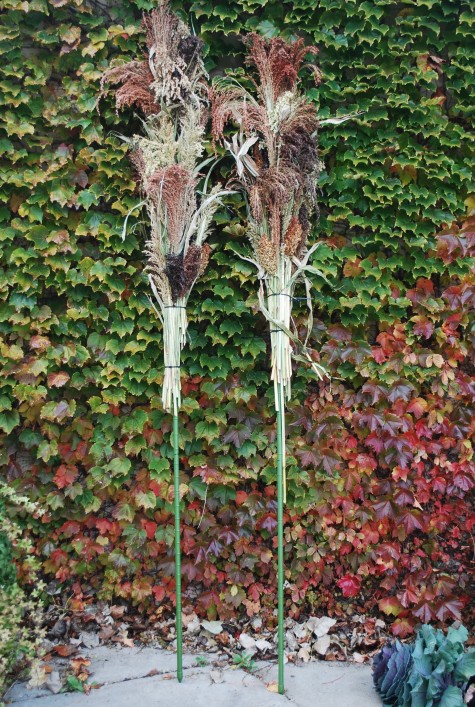
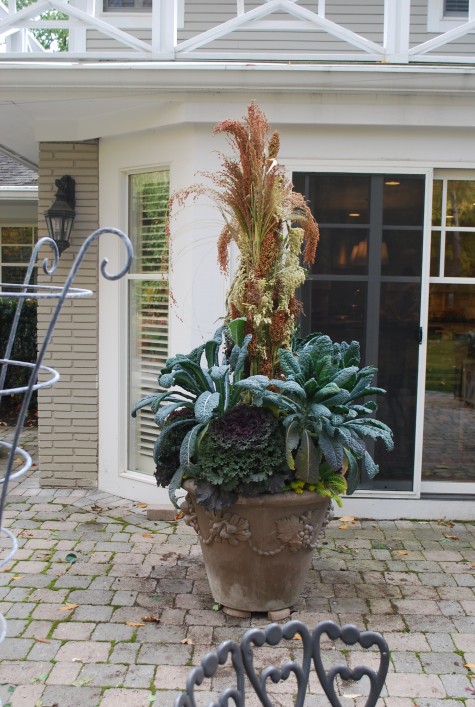 The metal stake is inserted as close to the bottom of the pot as possible. A listing, out of vertical centerpiece-on my top ten list of things I really dislike. The long fibrous panicle of the broomcorn plant arches over gracefully in a pot. I repeat that graceful arching with some leggy Tuscan blue kale; this combination is a good foil for those utterly organized cabbages.
The metal stake is inserted as close to the bottom of the pot as possible. A listing, out of vertical centerpiece-on my top ten list of things I really dislike. The long fibrous panicle of the broomcorn plant arches over gracefully in a pot. I repeat that graceful arching with some leggy Tuscan blue kale; this combination is a good foil for those utterly organized cabbages. 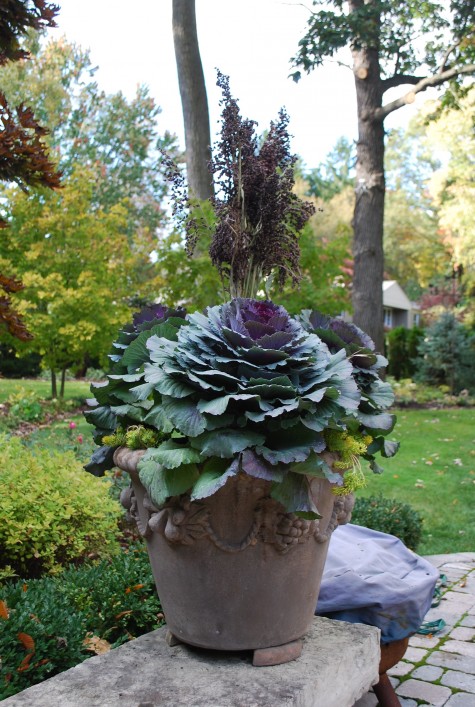 Sometimes I sort the broomcorn bunches for color. The dark stems are a beautiful compliment to this Francesco Del Re pot; plugs of angelina sedum infill the gaps. As I discussed yesterday, elevating the pots allows water to drain away freely. We will need this when dressing the pots for the winter.
Sometimes I sort the broomcorn bunches for color. The dark stems are a beautiful compliment to this Francesco Del Re pot; plugs of angelina sedum infill the gaps. As I discussed yesterday, elevating the pots allows water to drain away freely. We will need this when dressing the pots for the winter. The green-cream and peach sorghum contrasts well with its counterpart in a dark purple-brown. I do not know if any of these stems would pass muster for broom-making material, but they make for a great fall pot. That blue kale foliage is an unusual color in Michigan landscapes; it stands out.
The green-cream and peach sorghum contrasts well with its counterpart in a dark purple-brown. I do not know if any of these stems would pass muster for broom-making material, but they make for a great fall pot. That blue kale foliage is an unusual color in Michigan landscapes; it stands out. Ornamental cabbages only get better as the night temperatures drop; they color up. They are best planted as a tutu. Plants with a stiff aspect need some friendly and loose companionship. Thus this combination. The lime green angelina will take on an orange cast in cold weather, as in 37 degrees when I came to work this morning.
Ornamental cabbages only get better as the night temperatures drop; they color up. They are best planted as a tutu. Plants with a stiff aspect need some friendly and loose companionship. Thus this combination. The lime green angelina will take on an orange cast in cold weather, as in 37 degrees when I came to work this morning.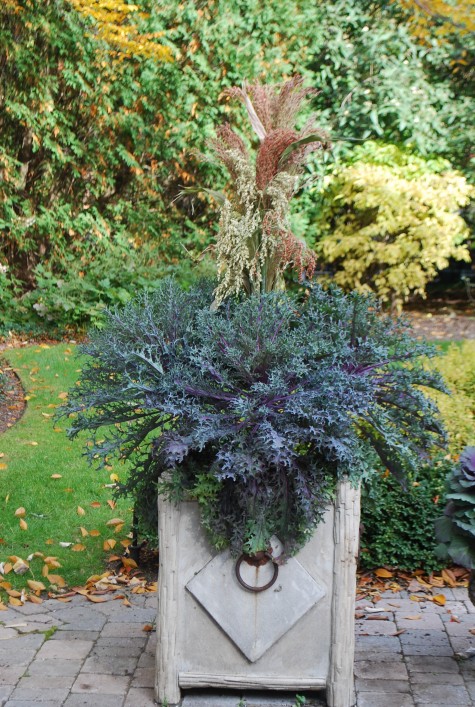 This lace leaf kale is all about air, at the same time that it defines an overall shape. What more could any gardener ask of a plant? As kales and cabbages shed their lower leaves, I may bury the trunk as needed in the soil, and pitch the head forward some. The entire arrangement-saucy enough to attract attention.
This lace leaf kale is all about air, at the same time that it defines an overall shape. What more could any gardener ask of a plant? As kales and cabbages shed their lower leaves, I may bury the trunk as needed in the soil, and pitch the head forward some. The entire arrangement-saucy enough to attract attention. 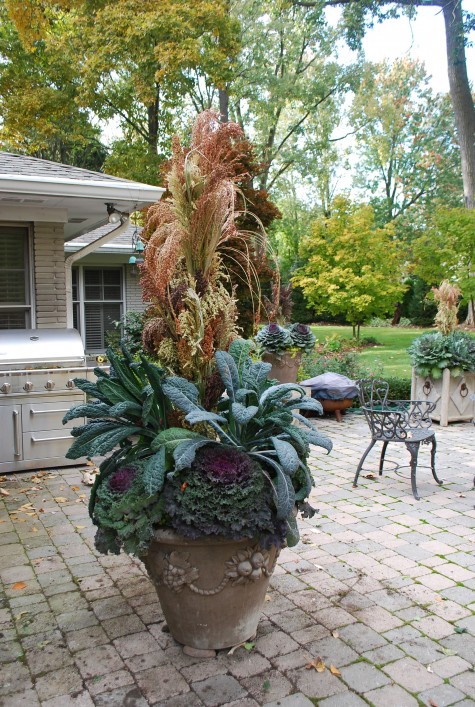
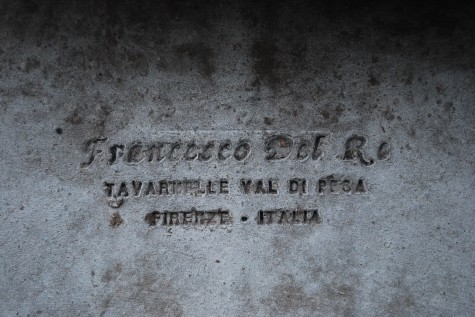
 Some forms are simply done, and reminiscent of the classic rolled rim terre cotta pot which has served gardeners well for centuries. Handmade terre cotta is fired for a long time-relative to the few hours allotted most machine made pots. This slow firing improves the strength and chip resistance remarkably. The flared shape makes potting and unpotting easy.
Some forms are simply done, and reminiscent of the classic rolled rim terre cotta pot which has served gardeners well for centuries. Handmade terre cotta is fired for a long time-relative to the few hours allotted most machine made pots. This slow firing improves the strength and chip resistance remarkably. The flared shape makes potting and unpotting easy.  Francesco Del Re fires their pots until they vitrify. Vitreous china and pottery refers to a clay which is subjected to sufficiently high heat for a time sufficient to turn the minerals in the clay glass-hard. I have left my handmade Italian pots out on occasion to weather the brutal Michigan winter-not a problem. But I am careful about certain things. I make sure there is a space, however small, between the pot, and the hard surface on which it sits. I might slide galvanized metal washers, or nickels under the pots. I want to insure that water drains away before it freezes and expands. Any water trapped under the pot will wreak havoc over a winter; thus I never recommend a winter outdoors for terre cotta to a client.
Francesco Del Re fires their pots until they vitrify. Vitreous china and pottery refers to a clay which is subjected to sufficiently high heat for a time sufficient to turn the minerals in the clay glass-hard. I have left my handmade Italian pots out on occasion to weather the brutal Michigan winter-not a problem. But I am careful about certain things. I make sure there is a space, however small, between the pot, and the hard surface on which it sits. I might slide galvanized metal washers, or nickels under the pots. I want to insure that water drains away before it freezes and expands. Any water trapped under the pot will wreak havoc over a winter; thus I never recommend a winter outdoors for terre cotta to a client.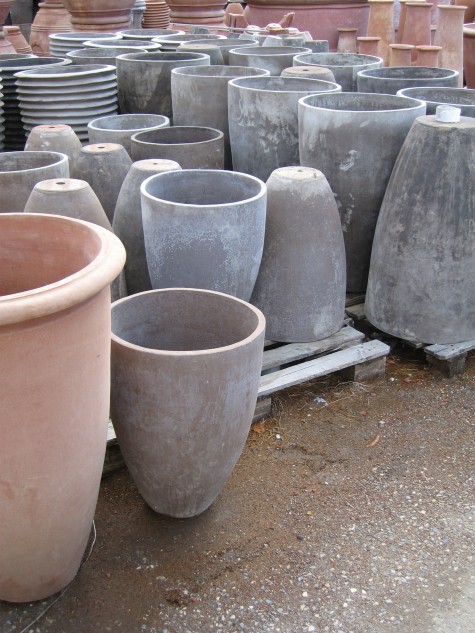
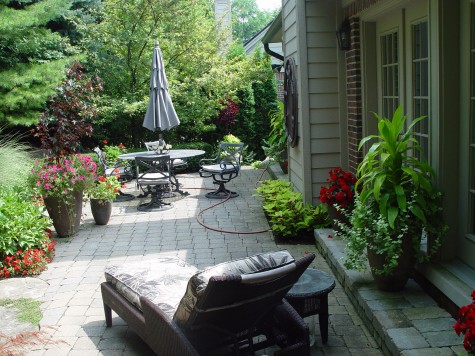 The pottery is guided by the design work of Elettra Brancolini; they refer to her as their artistic heart. Her distinctive design I would describe as softly modern, sometimes updated classical, and frequently very contemporary. I admire that the pottery has put their weight behind her hand. I am sure she gardens; the pots have a generous space at the top to plant. The proportions of this pot in all its sizes are perfection. They quietly and beautifully set off any planting. They are as beautiful indoors as out.
The pottery is guided by the design work of Elettra Brancolini; they refer to her as their artistic heart. Her distinctive design I would describe as softly modern, sometimes updated classical, and frequently very contemporary. I admire that the pottery has put their weight behind her hand. I am sure she gardens; the pots have a generous space at the top to plant. The proportions of this pot in all its sizes are perfection. They quietly and beautifully set off any planting. They are as beautiful indoors as out.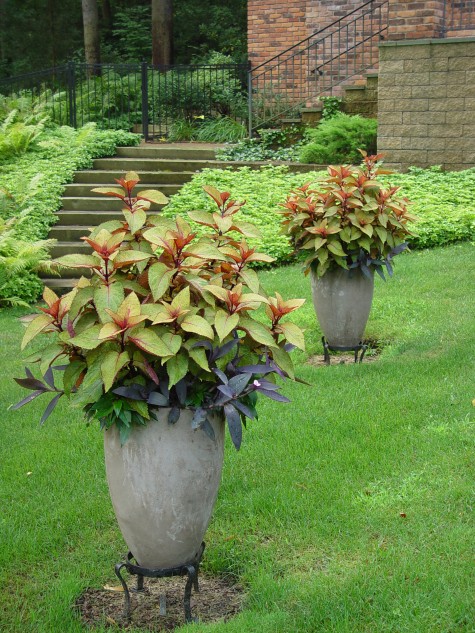
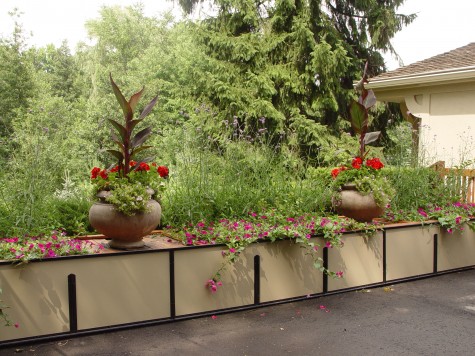 The color of the pots changes with the light, and appears different in different places. The creamy, barely yellow of this retaining wall has brought out the warm brown of the clay. Another cooler colored spot might make the pots read a warm grey.
The color of the pots changes with the light, and appears different in different places. The creamy, barely yellow of this retaining wall has brought out the warm brown of the clay. Another cooler colored spot might make the pots read a warm grey. 
